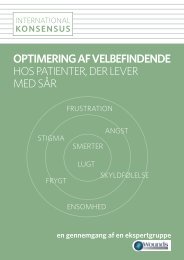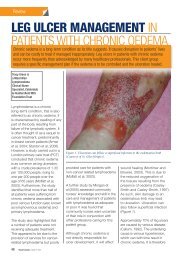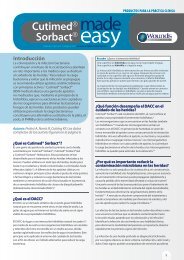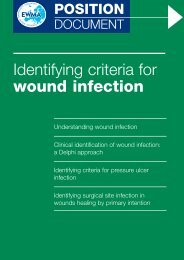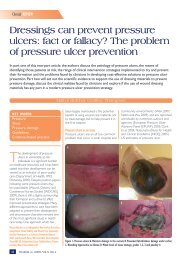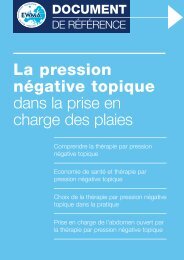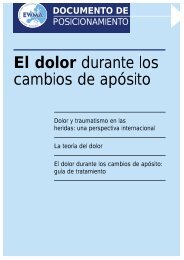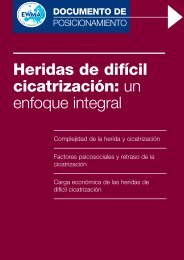You also want an ePaper? Increase the reach of your titles
YUMPU automatically turns print PDFs into web optimized ePapers that Google loves.
emoval (foam and gauze) – examined by<br />
immunohistochemistry for substance P and<br />
CGRP. Abstract presentato al Symposium<br />
on Advanced Wound Care and the Wound<br />
Healing Society Meeting in Orlando, Florida,<br />
17-20 Aprile 2010.<br />
36. Franczyk M, Lohman RF, Agarwal JP, et al.<br />
The impact of topical lidocaine on pain<br />
level assessment during and after vacuumassisted<br />
closure dressing changes: a doubleblind,<br />
prospective, randomized study. Plast<br />
Reconstr Surg 2009; 124(3): 854-61.<br />
37. Krasner DL. Managing wound pain in<br />
patients with vacuum-assisted closure<br />
devices. Ostomy Wound Manage 2002;<br />
48(5): 38-43.<br />
38. Paglinawan R, Colic M, Simon M. A<br />
comparative study of the influence of<br />
different pressure levels combined with<br />
various wound dressings on negative<br />
pressure wound therapy driven wound<br />
healing. Presentato al congresso European<br />
Tissue Repair Society, Malta, September<br />
2008.<br />
39. Jones SM, Banwell PE, Shakespeare PG.<br />
Interface dressings influence the delivery<br />
of topical negative-pressure therapy. Plast<br />
Reconstr Surg 2005; 116(4): 1023-8.<br />
40. Petzina R, Ugander M, Gustafsson L, et<br />
al. Hemodynamic effects of vacuumassisted<br />
closure therapy in cardiac surgery:<br />
assessment using magnetic resonance<br />
imaging. J Thorac Cardiovasc Surg 2007;<br />
133(5): 1154-62.<br />
41. Campbell PE, Smith GS, Smith JM.<br />
Retrospective clinical evaluation of gauzebased<br />
negative pressure wound therapy.<br />
Int Wound J 2008; 5(2): 280-6.<br />
42. Fraccalvieri M. Negative pressure<br />
wound therapy using the gauze and<br />
the foam: immunohistological and<br />
ultrasonography morphological analysis<br />
of the granulation tissue and the scar<br />
tissue. Rapporto preliminare di uno studio<br />
clinico presentato al congresso CORTE 4-6<br />
March 2010. Disponibile da: http://www.<br />
corteitalia.org/ (accesso Aprile 2010).<br />
43. Zannis J, Angobaldo J, Marks M, et al.<br />
Approfondimenti<br />
Comparison of fasciotomy wound closures<br />
using traditional dressing changes and the<br />
vacuum-assisted closure device. Ann Plast<br />
Surg 2009; 62(4): 407-9.<br />
44. Jeffery S. Advanced wound therapies in the<br />
management of severe military lower limb<br />
trauma: a new perspective. Eplasty 2009;<br />
9: e28.<br />
45. Chariker ME, Gerstle TL, Morrison CS. An<br />
algorithmic approach to the use of gauzebased<br />
negative-pressure wound therapy as<br />
a bridge to closure in pediatric extremity<br />
trauma. Plast Reconstr Surg 2009; 123(5):<br />
1510-20.<br />
46. Sjogren J, Gustafsson R, Koul B,<br />
Ingemansson R. Selective mediastinal<br />
tamponade to control coagulopathic<br />
bleeding. Ann Thorac Surg 2003; 75(4):<br />
1311-3.<br />
47. World Union of Wound Healing Societies.<br />
Principles of best practice: Vacuum assisted<br />
closure: recommendations for use: A<br />
consensus document. London: MEP Ltd,<br />
2008.<br />
48. McCord SS, Naik-Mathuria BJ, Murphy KM,<br />
et al. Negative pressure therapy is effective<br />
to manage a variety of wounds in infants<br />
and children. Wound Repair Regen 2007;<br />
15(3): 296-301.<br />
49. Morykwas M. Sub-atmospheric pressure<br />
therapy: research evidence. Presentato<br />
al First <strong>International</strong> Topical Negative<br />
Pressure Therapy ETRS Focus Group<br />
Meeting. London: ETRS; 2003; 39-44.<br />
50. Borgquist O, Ingemansson R, Malmsjö M.<br />
The influence of low and high pressure<br />
levels during negative pressure wound<br />
therapy on wound contraction and fluid<br />
evacuation. Wound Repair Regen In press.<br />
51. Borgquist O, Ingemansson R, Malmsjö M.<br />
Wound edge microvascular blood flow<br />
during negative-pressure wound therapy:<br />
examining the effects of pressures from -10<br />
to -175 mmHg. Plast Reconstr Surg 2010;<br />
125(2): 502-9.<br />
52. Nease C. Using low pressure, negative<br />
pressure wound therapy for wound<br />
preparation and the management of split-<br />
Malmsjö M, Ingemansson R, Sjögren J. Mechanisms governing the effects of vacuum-assisted closure in cardiac<br />
surgery. Plast Reconstr Surg 2007; 120(5):1266-75.<br />
thickness skin grafts in three patients with<br />
complex wounds. Ostomy Wound Manage<br />
2009; 55(6): 32-42.<br />
53. Malmsjö M, Ingemansson R, Martin R,<br />
Huddleston E. Wound edge microvascular<br />
blood flow: effects of negative pressure<br />
wound therapy using gauze or<br />
polyurethane foam. Ann Plast Surg 2009;<br />
63(6): 676-81.<br />
54. Kairinos N, Solomons M, Hudson DA.<br />
Negative-pressure wound therapy I: the<br />
paradox of negative-pressure wound<br />
therapy. Plast Reconstr Surg 2009; 123(2):<br />
589-98; discussion 599-600.<br />
55. Kairinos N, Solomons M, Hudson DA. The<br />
paradox of negative pressure wound<br />
therapy - in vitro studies. J Plast Reconstr<br />
Aesthet Surg 2010; 63(1): 174-9.<br />
56. Eberlein T, Fendler H. Using a new<br />
technique of negative pressure wound<br />
therapy (NPWT), variable pressure therapy<br />
(VPT), for the management of chronic,<br />
non-healing wounds. Presentato al<br />
Symposium for Advanced Wound Care<br />
(SAWC), Dallas, Texas, Aprile 2009.<br />
57. Malmsjö M, Ingemansson R. Variable,<br />
intermittent and continuous negative<br />
pressure wound therapy using foam or<br />
gauze: the biological effects on the wound<br />
bed including, blood flow, micro and<br />
macrodeformation, granulation tissue<br />
quantity, wound bed characteristics and<br />
tissue ingrowth into the wound filler.<br />
Abstract presentato al Symposium on<br />
Advanced Wound Care and the Wound<br />
Healing Society Meeting in Orlando,<br />
Florida, 17-20 Aprile 2010.<br />
58. Borgquist O, Ingemansson R, Malmsjö<br />
M. The effect of intermittent and<br />
variable negative pressure wound<br />
therapy on wound edge microvascular<br />
blood flow. Ostomy Wound Manage 2010;<br />
56(3): 60-7.<br />
59. Ubbink DT, Westerbos SJ, Nelson EA,<br />
Vermeulen H. A systematic review of<br />
topical negative pressure therapy for<br />
acute and chronic wounds. Br J Surg 2008<br />
95(6): 685-92.<br />
Per ulteriore documentazione si prega di visitare i siti www.woundsinternational.com oppure www.wounds-uk.com<br />
© <strong>Wounds</strong> <strong>International</strong> 2010<br />
6




